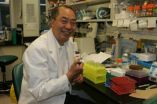(Press-News.org) VIDEO:
Many patients with advanced stages of cancer, AIDS, tuberculosis, and other diseases die from a condition called cachexia, which is characterized as a "wasting " syndrome that causes extreme thinness with...
Click here for more information.
Many patients with advanced stages of cancer, AIDS, tuberculosis, and other diseases die from a condition called cachexia, which is characterized as a "wasting" syndrome that causes extreme thinness with muscle weakness. Cachexia is the direct cause of roughly 20% of deaths in cancer patients. While boosting food intake doesn't help, and no effective therapies are available, new research in the Cell Press journal Cell Metabolism points to a promising strategy that may stimulate weight gain and muscle strength.
The research relates to a process that has been gaining considerable attention as a way to combat obesity: the browning of white fat. While white fat normally stores calories, brown fat burns them and generates heat in the process. Therefore, efforts to turn white fat into brown fat may help people lose weight.
Erwin Wagner, of the Spanish National Cancer Research Centre in Madrid, and his colleagues found that in mice and patients with cancer-associated cachexia, white fat undergoes significant changes and turns into calorie-burning brown fat. The transformation leads to increased energy consumption and organ wasting.
The team also discovered that inflammation plays an important role in turning white fat into brown fat during cancer-associated cachexia, which suggests a potential therapeutic target. Indeed, anti-inflammatory therapies, including the nonsteroidal anti-inflammatory drug (NSAID) Sulindac, ameliorated the severity of cachexia in mice.
"Our data suggest that inhibition of the browning of white fat represents a promising approach to ameliorate the severity of cachexia in cancer patients," says Dr. Wagner. "In addition, identifying biomarkers of browning at early stages of cancer development could help to predict which patients are going to develop cachexia and are good candidates to benefit from a preventive treatment."
INFORMATION:
Cell Metabolism, Petruzzelli et al.: "A Switch from White to Brown Fat Increases Energy Expenditure in Cancer-Associated Cachexia."
Brown fat found to be at the root of cancer-related wasting syndrome
2014-07-17
ELSE PRESS RELEASES FROM THIS DATE:
Obese women may have learning deficit specific to food
2014-07-17
Obese women have a deficit in reward-based learning, but only when food is involved. Importantly, say researchers who report their findings in the Cell Press journal Current Biology on July 17, those same women have no trouble at all forming accurate associations when the reward is money instead of food. The findings may lead to new, gender-appropriate ways to tackle the obesity epidemic.
"Our study shows that obesity may involve a specific impairment not in the processing of food itself, but rather in how obese individuals—or at least obese women—learn about cues in ...
Study identifies molecular key to healthy pregnancy
2014-07-17
Scientists have identified a crucial molecular key to healthy embryo implantation and pregnancy in a study that may offer new clues about the medical challenges of infertility/subfertility, abnormal placentation, and placenta previa.
Multi-institutional teams led by researchers at Cincinnati Children's Hospital Medical Center report their results in Cell Reports on July 17. The authors found that uterine expression of a gene called Wnt5a – a major signaling molecule in cell growth and movement in both embryo development and disease – is also critical to healthy embryo ...
First comprehensive library of master genetic switches in plants
2014-07-17
Researchers have created the first comprehensive library of genetic switches in plants, setting the stage for scientists around the globe to better understand how plants adapt to environmental changes and to design more robust plants for future food security.
The collection, which took more than 8 years and $5 million to create, contains about 2,000 clones of plant transcription factors, nature's genetic on/off switches. Manipulating these transcription factors enables scientists to improve plant traits such as cold resistance or seed quantity. The research will be published ...
Faithful cell division requires tightly controlled protein placement at the centromeres
2014-07-17
CAMBRIDGE, Mass. (July 17, 2014) – From fertilized egg to adult, the cells of the human body go through an astronomical number of divisions. During division of any of the body's roughly 30 trillion cells, DNA from the initial cell must be split precisely between the two resulting cells. Critical to successful cell division is the integrity of the centromere—a region of DNA on each chromosome where the cell division machinery attaches to segregate the chromosomes. For the segregation machinery to recognize this region, it must contain many copies of a pivotal protein known ...
One third of cancer patients are killed by a 'fat-burning' process termed 'cachexia'
2014-07-17
VIDEO:
One third of cancer patients are killed by a 'fat-burning' process known as cachexia.
Click here for more information.
Most cancer researchers are working on the biology of the tumour. However, Michele Petruzzelli, a member of Erwin Wagner's group at the Spanish National Cancer Research Centre (CNIO), has been looking for ways to attack the disease indirectly. He focused on the effects of tumours on the rest of the body, and not on the tumour itself. His work on the body's ...
Researchers discover new link between obesity, inflammation, and insulin resistance
2014-07-17
La Jolla, Calif., July 17, 2014 - A new study by researchers at Sanford-Burnham Medical Research Institute (Sanford-Burnham) has identified a new signal that triggers the events leading to insulin resistance in obesity. The signal causes inflammation in adipose tissue and leads to metabolic disease. The study, published July 17 in Cell Metabolism, suggests that blocking this signal may protect against the development of metabolic disease, type 2 diabetes, and other disorders caused by obesity-linked inflammation.
"We have uncovered a precise mechanism that explains how ...
New gene discovered that stops the spread of deadly cancer
2014-07-17
VIDEO:
Salk scientists have discovered the gene responsible for the aggressive spread of a common lung cancer.
Click here for more information.
LA JOLLA—Scientists at the Salk Institute have identified a gene responsible for stopping the movement of cancer from the lungs to other parts of the body, indicating a new way to fight one of the world's deadliest cancers.
By identifying the cause of this metastasis—which often happens quickly in lung cancer and results in a bleak ...
International research team discovers genetic dysfunction connected to hydrocephalus
2014-07-17
The mysterious condition once known as "water on the brain" became just a bit less murky this week thanks to a global research group led in part by a Case Western Reserve researcher. Professor Anthony Wynshaw-Boris, MD, PhD, is the co-principal investigator on a study that illustrates how the domino effect of one genetic error can contribute to excessive cerebrospinal fluid surrounding the brains of mice — a disorder known as hydrocephalus. The findings appear online July 17 in the journal Neuron.
Cerebrospinal fluid provides a cushion between the organ and the skull, ...
A region and pathway found crucial for facial development in vertebrate embryos
2014-07-17
CAMBRIDGE, Mass. (July 17, 2014) – A signaling pathway once thought to have little if any role during embryogenesis is a key player in the formation of the front-most portion of developing vertebrate embryos. Moreover, signals emanating from this region—referred to as the "extreme anterior domain" (EAD)—orchestrate the complex choreography that gives rise to proper facial structure.
The surprising findings, reported by Whitehead Institute scientists this week in the journal Cell Reports, shed new light on a key process of vertebrate embryonic development.
"The results ...
Tak Mak study in Cancer Cell maps decade of discovery to potential anticancer agent
2014-07-17
(TORONTO, Canada – July 17, 2014) – The journal Cancer Cell today published research led by Dr. Tak Mak mapping the path of discovery to developing a potential anticancer agent.
"What began with the question 'what makes a particular aggressive form of breast cancer cells keep growing?' turned into 10 years of systematic research to identify the enzyme PLK4 as a promising therapeutic target and develop a small molecule inhibitor to block it," says Dr. Mak, Director of The Campbell Family Institute for Breast Cancer Research at the Princess Margaret Cancer Centre, University ...





